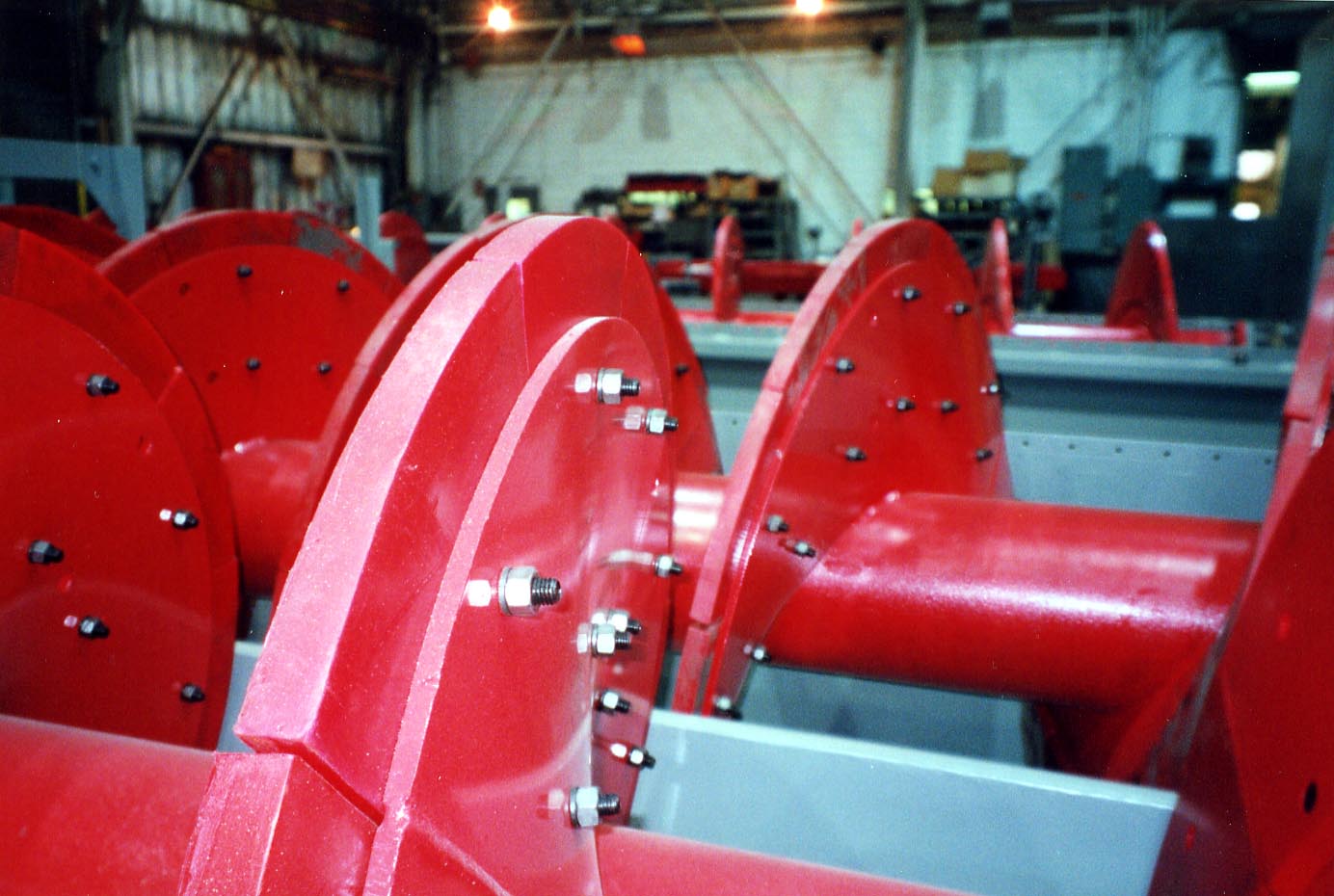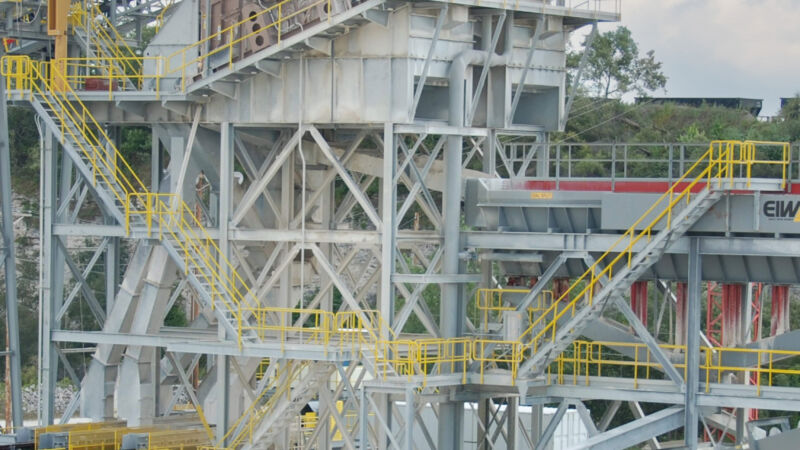
Industry Experts Discuss Screws, Cyclones, Sand Tanks and More Part 3
This is the third in a series of answers to common questions about sand washing equipment.
Industry experts Daniel Miles, P.E., President of Process Machinery, Inc.; Dave Schellberg, Product Support Specialist, EIW; and Mike Woolford, Sales/Territory Manager at Dibble Equipment, who combined have more than 100 years of experience in the aggregate processing industry, answer some common questions about sand washing and sand washing equipment.
In your experience, have you seen better wear life with iron shoes or urethane shoes for sand screws?
Mike Woolford: I’ll let you know in 18 months. I have a customer I’m just about to ship some screws to who sincerely believes that urethane is better. We’re shipping him two new double screws with one flight of urethane and one flight of Eagle Armor cast iron wear shoes. After a couple of years, someone is going to be right and someone is going to be wrong.

Urethane wear shoes.
I’m fully expecting to be wrong — I prefer the cast iron wear shoes. This customer has natural sand, and urethane does tend to wear well in natural sand.
Cast iron shoes wear nicely in that type of sand as well, and they don’t deflect when they get thin, which means the screw keeps pushing out the tons per hour we expect even after they’ve worn significantly.
My thoughts on the two styles of wear shoes:
- Cast iron wear shoes don’t deflect when they get thin. They keep working — I like that.
- Cast iron wear shoes are heavy, and they can crack if you drop them — I don’t like that.
- Cast iron wear shoes hold up beautifully in very hard, abrasive, manufactured type sands. Some of those manufactured sands will cut a urethane shoe.
Really, we can’t have this discussion without more fully defining our terms. You have to know the wear characteristics and the durometer of the urethane to understand what you’re getting.
"I also tend to prefer the urethane shoes that are cast with a steel backing in them so that the holes stay faithful over time. Otherwise, the shoes get caught on something, the holes elongate, and then we’re left with a shoe that’s all screwed up and no wear protection for part of our spiral." - Mike Woolford, Dibble Equipment
Likewise, all iron cast shoes are not the same. Some chilled white iron shoes have a nice long-wearing 600 Brinell outer layer, but once you wear through that outer layer, then you’re into a metal that wears no better than mild steel.
Some better cast iron wear shoes develop a tough but uniform wear property of close to 400 Brinell all the way through the shoe. I prefer the latter, but we should do a little research into exactly what’s in each type of shoe before we characterize one or the other as better.
An old fashioned experiment in your feed material is usually the best way to figure this out. Just install a few flights of urethane next to your cast iron wear shoes in your material, and you’ll know the answer in 18 months or so.
Daniel Miles: It depends on the material.
Unless a customer has existing experience with urethane, we typically use cast iron shoes. These tend to perform well for us in the territory, as we have a pretty soft limestone we are working with typically. After the first set of shoes wear out, we evaluate the wear time frame versus the cost and make decisions if we need to adjust.
I think this is an area where customers can get into trouble because the wear life of urethane is durometer-dependent and iron is Brinell-dependent. A 400 Brinell versus a 600 Brinell will wear faster, and the same holds true with urethane (higher durometer equals higher wear life). These harder materials usually cost more as well.
"I think it’s important that customers know what the manufacturer recommends as the standard hardness for the material in consideration and then use that information to adjust accordingly if desired." - Daniel Miles, Process Machinery, Inc.
Dave Schellberg: It depends on:
- The Brinell hardness of the iron shoe or the durometer of the urethane.
- The nature of the sand solids being dewatered.
The performance of iron shoes can vary depending on the alloy, which determines the Brinell hardness of the iron metal shoes. The higher the Brinell hardness number, the better the abrasion resistance and wear life.
Some foundries produce wear shoes that have a minimum 400 Brinell, while others pour a minimum 500 Brinell hardness. You may want to ask your supplier what the Brinell hardness or BHN is of an iron alloy wear shoe casting.
The hardness of urethane wear shoes can vary also. Some supply varying grades or hardness of polyurethane shoes. Some suppliers offer standard and premium grades, which are reflected in the prices you may be quoted.
Similar to the cost of iron alloy shoes, urethane shoe costs can vary also. Urethane grades vary in a value, referred to as durometer. Generally, the higher the durometer number, the higher the wear resistance is afforded in Fine Material Washer flight wearing shoes. A urethane flight shoe having a durometer of 90 to 100 should only be considered when getting prices on replacement parts.
Wearing shoes of any type generally perform well in round, alluvial or sometimes referred to as natural sand from a glacial deposit. It also depends on the gradation, as a more coarse concrete sand wear rate will be higher than a finer mason sand.
Manufactured sands, fine rock solids generally being -3/16” (4 mesh) or 5 mm, can vary in their chemical characteristics. All have angular surfaces from the actions of blasting in quarrying and crushing in several stages.
Some acceptable manufactured sands are of a high calcium carbonate content with a low silica content, while others like some granites, schist or trap rock crushed sands are extremely abrasive even in finer sand particle sizes. In some of these high silica, manufactured sands, a high Brinell iron alloy wear shoe is the best material.
In all types of wear shoe material, a thicker section wear shoe, while costing more per unit, is used to reduce the frequency of needing to replace wear shoes.
"One needs to compare the cost versus the performance for what’s best in your situation." - Dave Schellberg, EIW

Additional questions will be answered in upcoming blogs. If you have a question for one of our experts, please contact us.

